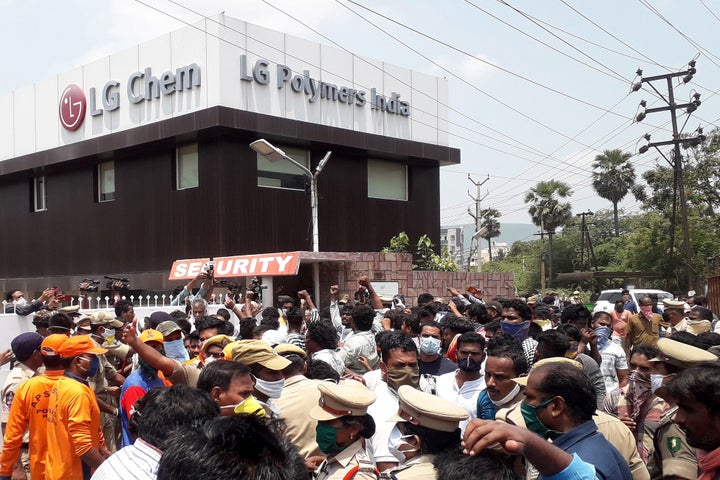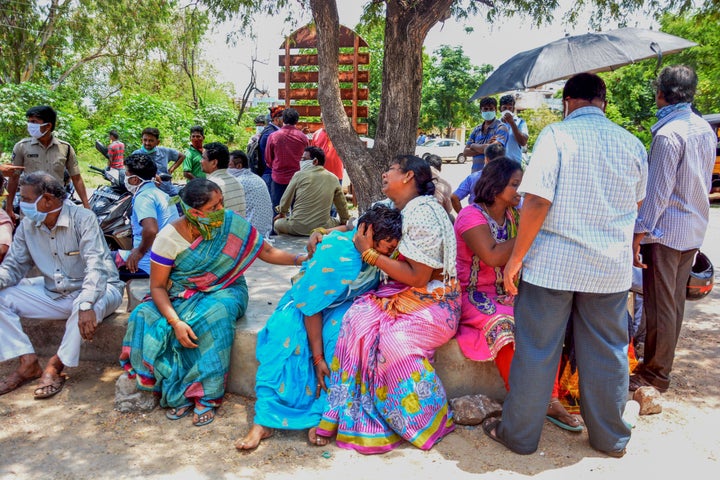
Hyderabad, TELANGANA: A timely siren and proper evacuation training could have saved the 12 people who died in Visakhapatnam after inhaling gas leaked from an LG Polymers plant in the early hours of May 7, according to a report by two independent experts.
The report, by Sagar Dhara, a Hyderabad based environmental engineer and former faculty member of BITS Pilani, and K. Babu Rao, a retired senior scientist of Indian Institute of Chemical Technology (IICT), Hyderabad, was prepared with estimates deduced using the ALOHA software, which was used to model the extent of gas released from the faulty tank inside the LG plant.
Taking into account the storage capacity of the plant (1,900 tonnes), wind speed (less than 1 m per second) and the proximity of residential villages, if a siren had sounded five minutes after temperature in the tank, which contained polymerized styrene, rose over 65°C, even residents living within a radius of 0.5 km from the plant would have had 18-27 minutes to evacuate the premises, the yet-to-be-published report, a copy of which is with Huffpost India, calculates.
Andhra Pradesh Chief Minister Y.S. Jagan Mohan Reddy had said in a press conference held on the day of the leak that he was “concerned that an alarm did not sound when the leak happened”. He, however, also praised LG Polymers as a “reputed company” in the same media briefing.
While an expert committee has been set up to probe the reasons for the lapse, it has not submitted its report yet. The company has not yet provided an explanation as to why an alarm did not alert residents to the leak, as per government rules.

On the day of the leak, Andhra Pradesh politicians had laid the blame for the mishap on LG Polymers and the industrial policies put in place by the former Telugu Desam Party government. The next day, the state government decided to inspect the premises of existing hazardous industries to check if the population density around the plants has gone up significantly.
“In several areas, after the plants were set up, the population has increased. For new companies which want to start functioning in AP, Andhra Pradesh government has decided to bring out a new Industries Act after the lockdown ends. This will have stringent checks for polluting industries which want to start operations in AP. The Chief Minister has been clear that AP will not be a dumping yard for such industries,” said industries minister Mekapati Goutham Reddy.
Seoul-based LG Polymers, which sent a team to inspect the plant on 12 May, has said in a release dated May 16 that they completed transportation of styrene monomer inventory and tanks to South Korea “to prevent and eliminate all risk factors”. The plant has been non-operational. since the accident occurred.
While LG chairman Koo Kwang-mo issued a public apology for the accident, news reports also say that LG Polymers has filed a defamation case against the Andhra Pradesh Pollution Control Board (APPCB) in the Supreme Court.
Reddy has said that the leak occurred when workers were “doing maintenance work” in the plant after it was shut for 40 days because of the national lockdown. The plant had 15 workers on site when the leak took place, a company representative had told the media. While the workers are believed to have fled the spot, a resident alerted the police by making a call to the control room at 3.30 am.
What else does the report say?
People living in a radius greater than 0.6 km from the plant would have got 30-40 minutes to evacuate the premises if an alarm had sounded within five minutes, said the report. Those who lived within a radius of between 2.6 km and 6.3 km from the plant would have got 80-169 minutes, or over two-and-a-half hours, to leave the area.
According to media reports, the majority of the victims of the leak lived within 2-6 km radius of the plant.

Both Dhara and Rao have earlier worked on similar reports on corporate violations that have forced governments to take note.
In 2019, a report prepared by Dhara on the environmental hazards caused by an Adani Group-owned coal plant in Udupi prompted the National Green Tribunal to revoke the plant’s environmental clearance. The plant was also asked to pay Rs 5 crore as fine to the Central Pollution Control Board. Rao’s most recent scientific report was on the environmental hazards of uranium mining in the Nallamala forest of Telangana and Andhra Pradesh. Following the intervention of activists including Rao, the Telangana government denied permission for uranium mining within the state boundaries despite the centre’s clearance.
In the LG Polymers report, the researchers point out that the three areas designated as red, orange and yellow zones—according to their proximity to the plant and exposure to a potential leak—were all affected by the leak.
According to the report, the accident could have happened because the national lockdown “may have reduced the inhibitor concentration in the tank, or no inhibitor was added for a considerable period, and the refrigeration system was either not working or was working insufficiently for some time before the accident”.
This, the researchers say, may have increased the temperature inside the tank up to 180°C. On May 7 morning, a staff member of LG Polymers had also admitted that the company was not able to maintain the tank temperature below 20°C “because of the lockdown”.
AP industries minister Reddy told HuffPost India that the government had asked all industries to have “enough personnel on site to restart the plant after lockdown relaxation” and that they had issued “some guidelines and some checklists”.
LG Polymers had not asked the government for clearance to operate because they had not planned to restart operations yet, he said.
“They were getting the plant ready for production when the accident happened,” Reddy said.
The findings of Dhara and Rao’s report are similar to an evaluation done on May 7 by Sukanya Nair of Centre for Science and Environment, New Delhi. Stating that all hazardous industries which plan to reopen after the lockdown should strictly follow maintenance and start-up protocol, Nair said in her report that, “the problem began as a result of styrene gas not being stored at the appropriate temperature. This caused pressure to build up in the storage chamber and led the valve to break, resulting in the gas leakage”.
While Dhara and Rao have recommended temperature below 18°C for safe storage of styrene, Nair in her report had maintained that the temperature should have been less than 17°C. The latter’s report says that “the container that was being used to store styrene gas was old and not properly maintained…Another issue was the defunct VOC (Volatile Organic Compound) detection system at the plant; there is no monitoring mechanism that was installed to specifically detect styrene”. VOC detection system usually acts as an alarm or is usually linked to a siren.
Evacuation training a must
Dhara, however, emphasised that a siren alone would not have helped local residents.
“As per Manufacture, Storage and Import of Hazardous Chemical rules, 1989, the surrounding villagers should have been trained in evacuation procedure. This would have prevented casualties,” he said.
According to the report, the company violated not just the 1989 rules which stipulate that “the bystander population be told of the risk they were at and trained in evacuation procedures in the event of an accident”, it also failed to follow a 1999-2000 APPCB order which states that, “all facilities handling hazardous chemicals must put a board intimating the maximum vulnerable zone in the event of a catastrophic accident at their main gate… that is visible to public”.
While many companies have put up the warning boards, LG Polymers failed to do so, Dhara added.
On May 8, The Indian Express reported that LG Polymers had no clearance from APPCB to expand its production capacity. Trade union activists also allege that the ISO-certified plant had been “self-regulating” its pollution levels and wasn’t inspected at regular intervals. AP Industries Minister Reddy also confirmed that the company has been “self-regulating” its operations, including pollution control.
“Self-auditing of pollution controls means that based on complaints from the public, sudden inspections from industries department cannot be made. Only annual checking can be held in such self-regulated plants,” said Ch Narsinga Rao, president of Fertilisers Union, Visakhapatnam Steel Plant Employees Union and state president of the Centre of Indian Trade Unions.
The accident could have occurred only if the workers who were on duty at the plant had skipped two or three of the start-up controls during the maintenance work held on May 7, said Rao, who has been a trade unionist and industrial employee at Visakhapatnam steel plant for 40 years.